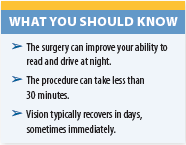Innovations in Cataract Procedures
If you use your cellphone to illuminate a restaurant menu or squint while driving at night because there’s too much glare, cataracts are the likely culprit.
“Cataracts scatter light and prevent it from entering the eye, and the scatter causes glare in addition to dimmed vision,” explains Mitra Nejad, MD, Assistant Clinical Professor of Ophthalmology, Cataract and Refractive Surgery Division, Stein Eye Institute, David Geffen School of Medicine of UCLA. “Cataracts make night driving difficult due to oncoming headlights, and it’s hard to read fine print because you need more light. Cataract surgery essentially reverses this effect and allows light to enter the eye. Glare is reduced and reading becomes easier.”
A Long History
Cataract surgery is one of the most common and oldest procedures done worldwide. Early attempts at treating cataracts date back to the fifth century BC. As knowledge of eye anatomy and eye disease expanded, so did treatment approaches. The first cataract extraction was performed in 1947, in Paris, and two years later a British ophthalmologist implanted the first intraocular lens. Subsequent innovations built upon this groundbreaking work, leading to multifocal lens implants and vision correction.
“Cataract surgery is a relatively easy and highly successful procedure,” says Dr. Nejad. “It’s done under local anesthesia (so you don’t have to be put to sleep), takes less than 30 minutes, and vision recovers in days (sometimes immediately). If patients knew this early on, they may have less apprehension about seeking such care for their eyes.”

Normal vision (left) vs.
vision before cataract surgery (right). Cataracts cause images to appear blurry and dull.

How Cataracts Form
The clear lens of the eye is made up mostly of protein and water, arranged in an orderly pattern that allows light to pass through it. But as we age, the proteins begin to clump, causing the lens to cloud and turn yellow. This is a normal process that occurs in most people, and it doesn’t always affect vision. But in about 50% of the people who develop a cataract, vision is affected with the telltale light glare, reading difficulties, and dulled colors.
 Scientists are not sure what causes the clumping associated with cataracts, but it is probably a combination of factors. One likely contributor is a class of chemicals known as free radicals, which can damage cells. They are generated by natural biochemical processes, notably metabolism, infection, and environmental pollutants. Ultraviolet (UV) light also contributes to cataract formation, possibly in part by generating free radicals. Chemicals called antioxidants can neutralize free radicals, but the body’s ability to produce antioxidants decreases with age.
Scientists are not sure what causes the clumping associated with cataracts, but it is probably a combination of factors. One likely contributor is a class of chemicals known as free radicals, which can damage cells. They are generated by natural biochemical processes, notably metabolism, infection, and environmental pollutants. Ultraviolet (UV) light also contributes to cataract formation, possibly in part by generating free radicals. Chemicals called antioxidants can neutralize free radicals, but the body’s ability to produce antioxidants decreases with age.
Continuing Innovations
In 1967 an American ophthalmologist revolutionized cataract surgery when he introduced phacoemulsification, a method for breaking up and removing the cataract with ultrasound. In 2001, femtosecond laser technology further advanced the procedure. This approach pretreats and softens the cataract, making the surgery gentler on surrounding tissues. The laser also can correct astigmatism, a refractive error that blurs vision, during the procedure.
“The latest developments in cataract surgery involve how we do the surgery and which lens implant we use,” explains Dr. Nejad. “Using femtosecond laser-assisted cataract surgery and other intraoperative technology increases our precision, and the trifocal and/or astigmatism-correcting implants allow us to decrease our patients’ dependence on glasses.”
Medicare and most private health-insurance policies will pay the costs of cataract surgery if you meet certain criteria. Check with your insurance provider to find out how much of your surgical costs they will cover. Some options, like laser enhancement or laser-assisted surgery, and more expensive “premium” lens implants are generally not covered by insurance, and this can add substantially to costs. Even for a basic cataract procedure paid for by Medicare, out-of-pocket costs can still be substantial.
When to Treat Cataracts
Cataracts are slow growing and for some people may never be bothersome enough to require intervention. But if your activities of daily living, such as driving or reading, are affected by waning vision, and your doctor sees a cataract that can explain the vision changes, then surgery is certainly an option worth considering. “Very rarely, having an advanced cataract can lead to glaucoma or mask other eye conditions that require timely interventions,” says Dr. Nejad. “Therefore, you should still get routine eye exams, even if you are not ready for surgery.”
The post Innovations in Cataract Procedures appeared first on University Health News.

